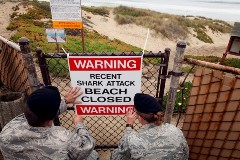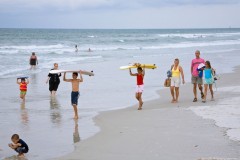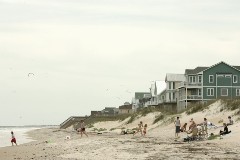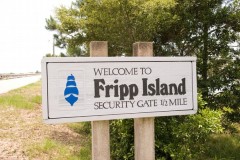Sharks are part of the natural environment of the ocean, in fact without them, the natural order of marine life would be disrupted. When we go into the ocean, we are invading their habitat, keep in mind that they merely have a curious need to search for food, all they were created for was to swim, eat and make other sharks. Often bites on surfers or swimmers is not predatory, its investigating their next meal a common practice of sharks to experiment, check out this article from Yahoo Travel written by online author John Giuffo:
Source:
*This article was cut and pasted from a lead story authored by John Giuffo entitled "America's Most Shark-Invested Beaches" The following article can be referenced at:
http://travel.yahoo.com/p-interests-40447719
"America's Most Shark-Invested Beaches"
Courtesy of Forbes Images
By the time a lifeguard got to him, it was too late. Stephen Schafer was kitesurfing 500 yards off an unguarded part of Stuart Beach, in Martin County, Fla., last February when he was attacked by a swarm of sharks. “He got bit after he presumably wiped out, a very serious bite,” says George Burgess, director of theInternational Shark Attack File at the Florida Museum of Natural History. Schafer was rushed to a local hospital, where he died of his wounds.
While shark attacks are rare, they’ve been on the rise, with 79 attacks in 2010—the most dangerous year for shark attacks in a decade. Here is our list of some notable locations for shark attacks in 2010 and 2011. Although no one beach is more likely to be prone to shark attacks than another, these are mostly part of larger areas known to be where sharks and humans come into contact with each other.
Shark attacks are relatively common in the waters off northern California, but one attack in central California in 2010 drew a lot of attention. Nineteen-year-old surfer Luke Ransom was catching large waves in the waters off Vandenberg Air Force base near Santa Barbara, when he was attacked by an 18-foot great white. The surfer did not get back to shore in time and bled to death.
Courtesy of Forbes Images
There were 13 unprovoked shark attacks – one fatal – in Florida in 2010, statistically the most likely place in the world to get bitten by a shark. That likelihood shows no sign of abating this year. In addition to an attack on dive instructor Daniel Webb on June 12, the most recent attack was on a 19-year-old swimmer in New Smyrna Beach on June 6, the third person this year to get bitten by a shark in part of the so-called “red triangle.”
Courtesy of Forbes Images
North Carolina has had a moderate amount of shark attacks in the past decade, including five last year, up from one the year before. One of those victims was Carley Schlentz, a 13-year-old girl from Greensboro, N.C., who was attacked near Topsail Island. She was bitten twice before she made it out of the water, and required 60 stitches to close the wounds.
Courtesy of Forbes Images
Shark attacks are relatively rare in East Coast waters north of Florida, and in South Carolina particularly, but last year the state was the site of four attacks, all of which were non-fatal. One of those sharks attacked six-year-old Ella Morris, who was playing on a boogie board with her father when a shark bit into Ella’s leg and dragged her underwater. Ella’s father chased the shark away with the board and ran ashore to a nearby firehouse for help. Ella’s wound required 22 stitches but she survived the attack.
Courtesy of Forbes Images
Hawaii is also one of the world’s hotspots for shark encounters. The islands were the location of four unprovoked attacks last year and a few this year as well. Two of those attacks occurred within three days of each other in the waters near Lyman Beach in Kona, the first recorded attacks in that part of the big island. Theresa Fernandez was surfing in the waters off Kona when she felt something hard hit the bottom of her board. When the rear of her surfboard was pulled under the water, she paddled furiously to get away from what she knew was a shark. Luckily, Fernandez and another surfer, Alayna DeBina, both escaped their encounters without injury.
 The yachting community enlist the services of yacht brokers because they are in tune with the yachting family, often expensive yachts are purchased by those effluent buyers upgrading to a bigger vessel, looking to sell the smaller yacht they currently own. This transition helps the buyer and seller get together more easily and helps have a contact to go to when you have questions.
The yachting community enlist the services of yacht brokers because they are in tune with the yachting family, often expensive yachts are purchased by those effluent buyers upgrading to a bigger vessel, looking to sell the smaller yacht they currently own. This transition helps the buyer and seller get together more easily and helps have a contact to go to when you have questions.



